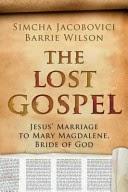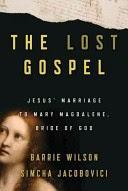 While I was noodling around on the internet to remind myself of the exact titles of Marcus Borg's and Burton Mack's Lost Gospel books last night (see Q, Doctor Who and the difference between "lost" and "hypothetical"), I came across something that may be of interest to students of Simcha Jacobovici's work. Regular readers will know that I have often reflected critically, but I hope fairly, on the claims the filmmaker Simcha Jacobovici has made about Christian origins, which include having discovered the tomb of Jesus, his wife Mary Magdalene, and their son Judas.
While I was noodling around on the internet to remind myself of the exact titles of Marcus Borg's and Burton Mack's Lost Gospel books last night (see Q, Doctor Who and the difference between "lost" and "hypothetical"), I came across something that may be of interest to students of Simcha Jacobovici's work. Regular readers will know that I have often reflected critically, but I hope fairly, on the claims the filmmaker Simcha Jacobovici has made about Christian origins, which include having discovered the tomb of Jesus, his wife Mary Magdalene, and their son Judas.  Although the details are fairly scant at the moment, it seems that Jacobovici has something truly sensational lined up. This book, The Lost Gospel, has been announced by Pegasus Press and is set to appear on 15 April 2014. Although this will be just in time for the Easter market, it is probably worth pointing out that there is many a slip between cup and lip and it may be that the book does not make that deadline. After spotting the book on Amazon, I did a bit more googling and found further references to it with different publishing dates. It was projected for 3 March 2011 (Overlook press) and 30 March 2010 (Harper Collins Canada).
Although the details are fairly scant at the moment, it seems that Jacobovici has something truly sensational lined up. This book, The Lost Gospel, has been announced by Pegasus Press and is set to appear on 15 April 2014. Although this will be just in time for the Easter market, it is probably worth pointing out that there is many a slip between cup and lip and it may be that the book does not make that deadline. After spotting the book on Amazon, I did a bit more googling and found further references to it with different publishing dates. It was projected for 3 March 2011 (Overlook press) and 30 March 2010 (Harper Collins Canada).I must admit that any book that announces a "lost gospel" is bound to gain my interest. So what do we know about it so far?
The book's subtitle is Jesus' Marriage to Mary Magdalene, Bride of God. and the book blurb tells us a little more (emphasis original):
In a startling follow-up to the New York Times bestseller The Jesus Family Tomb, a historical detective story that unravels a newly translated document filled with startling revelations and fascinating detail about the life and times of Jesus.
Gathering dust at the British Museum is an ancient manuscript of the early Church, written by an anonymous monk. The manuscript is at least 1,600 years old, possibly dating to the first century. This revelatory book provides the first ever translation from Syriac into English of a profound document—some twenty-nine chapters in length —that tells us the inside story of Jesus’ social, family, and political life.
The Lost Gospel takes the reader on an exciting historical adventure through this highly informative ancient manuscript. The authors were easily able to decode the basic symbolism, but what the authors eventually discovered is as surprising as it ground-breaking: the confirmation of Jesus' marriage to Mary Magdalene; the names of their two children; the towering presence of Mary Magdalene (who was a Gentile priestess), a serious plot on Jesus’ life in 19 C.E. prior to the crucifixion; an assassination plot against their children; Jesus’ connection to political figures at the highest level of the Roman Empire—Emperor Tiberius and his protégé Sejanus; and a religious movement that antedates that of Paul—the Church of Mary Magdalene.
None of these discoveries are the authors’ claims: they are what this ancient manuscript reveals now that it has been decoded. Part historical detective story, part travelogue about a journey into the heart of an ancient world, The Lost Gospel reveals a secret that's been hiding in plain sight for centuries.This is really intriguing. The blurb to some extent retains the sense of mystery and sensation, but there are a few clues about the identity of the manuscript. It was found in "the British museum", it is anonymous, it is Syriac and it is dated to the fifth century. My guess is that the line "possibly dating to the first century" refers to the theorized date of the work to which the fifth century Syriac manuscript witnesses, but that is not clear.
The content does not correspond to any early Christian work I am aware of, so it is definitely one that lots of us will be watching with interest.
I must admit that after reading the book's blurb, I was so intrigued that I googled for more. It is co-authored with Barrie Wilson of York University, Toronto, who has the following on his website:
Watch for
THE LOST GOSPEL
Book and documentary - Spring 2014
An exploration of a mysterious document prized by early Christians that takes us into the political ambitions and connections of Jesus along with his human and family side.
Who would become "King of the Jews" - Herod Antipas who so coveted the title? Jesus who was crucified for this claim? Herod Agrippa?
Who was Pontius Pilate and what were his connections to Rome?
How were Jesus and those closest to him imaged by his early followers on the world stage, outside the confines of Middle Eastern politics?
And just who were Jesus' closest companions?
This document takes us well beyond the canonical gospels shaped by Paul’s theology and answers questions they fail to address.So the Spring 2014 date is here confirmed -- and there is the additional news that a documentary is planned to accompany the book. It may well be, then, that a big media event is planned to publicize "the lost gospel", with TV documentary, book and website.
Wilson's blurb is tantalizing. It is mainly composed of questions, but if the "mysterious document" indeed features Herod Antipas, Herod Agrippa, Pontius Pilate and "Jesus' closest companions", it will be well worth studying.
There is not much about it yet on the Associated Producers' website, though there is the following statement, which confirms news of the documentary associated with the book:
Upcoming is “The Bride of God” co-written with Professor Barrie Wilson. Harper Collins is the publisher, Discovery Science and Vision Canada will air the companion film.I also noticed, while googling, that there were quotations on the internet (including in this blog, which I had forgotten about!) from older versions of Wilson's website, so I took a closer look and found the following details:
. . . . . Lurking in the British Museum is an ancient Syriac manuscript dating from the 6th century but translated from much earlier Greek writing. Scholars have known about it for almost 200 years but have not known what to make of it. No translation exists based on the Syriac text. We provide a first-ever translation from the Syriac.
More importantly we use decoding techniques employed by early Christians themselves as they sought to understand biblical writings. They saw scripture differently than we do. An ancient Syriac introduction to manuscript – never before translated – tells us that the writing we examine contains an embedded meaning.
As we let this ancient writing speak for itself, it opens up a fascinating, hitherto unknown world. The results are startling:The site went on to say "This book will be tied into an episode on a 7-part History Channel documentary series, "Secrets of Christianity," to air likely early 2011," but it looks like they decided not to include it in that series (which has six parts) and to save it for next year.
More than any other writing, this manuscript places Jesus on the world stage, as a major player within the Roman Empire.
- The full humanity of Jesus and what it means for understanding his family life and sexuality.
- Roman politics and why Jesus had to fear for his life, constantly on the move to avoid Herod Antipas who successfully caught and executed John the Baptist.
- Pontius Pilate and his connections to the Roman Emperor Tiberius and to the real power behind the imperial throne, Sejanus.
- A different theology of redemption than the more familiar one promoted by Paul (as a sacrificial atonement for sin).
- A new early Christian movement alongside the ones led by Paul, by James and by the Gnostics.
- Strange archeological depictions of Sun Gods and Zodiacs that have hitherto defied analysis.
Since Wilson's website speaks about the document having been known for almost 200 years, there must be some who are more familiar with this document than I am. In the mean time, and since I am ever the optimist, I look forward to hearing more in due course.
Nevertheless, if there are some grounds for caution, one might see them in the idea that this work will provide "the confirmation of Jesus' marriage to Mary Magdalene". Since there are no ancient sources that speak of Jesus' marriage to Mary Magdalene, it is not clear at this stage how a newly discovered work could provide "confirmation" of this. The note that she is a "Gentile priestess" is curious and, one would have thought, makes it unlikely that the work goes back to the first century, so too the idea that they had two named children.
Some might find grounds for caution also in the idea that the authors had to "decode the basic symbolism" in the manuscript. The "discoveries" in the manuscript are revealed "now that it has been decoded". The idea that ancient manuscripts require "decoding" is a favorite element in popular historical fiction like The Da Vinci Code, and the metaphor is regularly used in Jacobovici's own work (see, for example, the Da Vinci Code and the Talpiot Tomb). However, it is worth noting that there is some reported substance to the claim here in that the manuscript features an introduction stating that the document has "an embedded meaning".
All in all, though, I am looking forward to hearing more about this exciting find and -- as always -- I will approach the claims made with an open mind.
